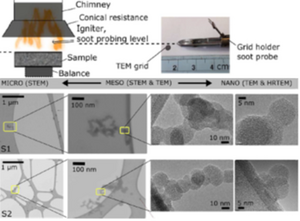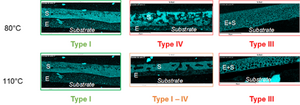Polymers/Soft Matter
Contribution of scanning electron microscopy for the study of piezoelectric nanocomposites
Piezoelectric nanocomposites classically combine the high piezoelectric properties of ceramics and the good mechanical properties of polymers. If, in addition, the polymer is an electroactive polymer, it is possible to combine the piezoelectric responses of the two materials. For these hybrid materials, the dispersion of the nanoparticles and the interfacial adhesion between the nanofillers and the polymer matrix are key parameters. In the context of a study carried out on piezoelectric composites based on a poly(vinylidene fluoride) matrix (PVDF) loaded with barium titanate nanoparticles (BaTiO3), we used a dopamine derivative, nitrodopamine, as a functionalizer to improve interfacial adhesion. Scanning electron microscopy performed on cryofractured samples allows to visualize the quality of the charge dispersion in relation with the optimization of the composite fabrication process and the difference in charge - matrix interaction without (a) and with nitrodopamine (b). The presence of cavities can cause, under electric field, a breakdown and therefore a degradation of the material. On the other hand, to be piezoelectric, the PVDF must be stretched. After uniaxial stretching, the interfacial adhesion between the nanoparticles and the polymer matrix is preserved (c). The structure and the piezoelectric properties of these composites were analyzed at macroscopic and local scales (Defebvin et al., 2017, Ferri et al. 2020).
Sophie Barrau (ISP-UMET), Juliette Defebvin (ISP-UMET), Jean-Marc Lefebvre (ISP-UMET), Adeline Marin (ISP-UMET), Joël Lyskawa (ISP-UMET) in collaboration with Anthony Ferri, Antonio Da Costa et Rachel Desfeux (CMNM-UCCS-Université d’Artois)
Characterization of in-flame soot from balsa composite combustion during fire test
Soot is one of the degradation products of material burning, having the fingerprints of the conditions in which it is formed. In this work, part of the ERC FireBar Concept project, in-flame soots were probed from flaming combustion of the material during mass loss cone calorimeter tests. Electron microscopy imaging was performed to analyze the size of the particulate media at multiscale (SEM-STEM and TEM). The size of the aggregates and the primary particles were found to be inherent to the fire scenario. Nanoscale structure of in-flame soot was consistent with the results of thermogravimetric analysis of emitted-deposited soot. This semi-quantitative study contributes to soot observations in fire scenarios and constitutes the first application of soot probing by thermophoresis in a bench-scale fire scenario simulated by cone calorimetry (Okyay et al., 2018).
Gizem Okyay (ISP-UMET), Séverine Bellayer (ISP-UMET), Fabienne Samyn (ISP-UMET), Maude Jimenez (ISP-UMET), Serge Bourbigot (ISP-UMET)
Self-stratifying flame retardant coatings
To provide durable fire retardancy to a material through its surface, different coatings with specific functional properties (e.g. adhesive, fire retardant and hydrophobic properties) are needed. These multilayered systems usually require complex application and curing procedures. It is thus highly desirable to reduce the number of layers to a minimum, providing the equivalent or better overall performance of the current systems, forming multilayered paint films from a single coat system. The general objective of the project is to develop an innovative eco-friendly process to stimulate the fire retardant coating industry. This subject has already been studied in the Stic ANR project and is currently studied in the Biostic project. SEM couple EDS analyses are carried out to allow the characterization and imaging of the different state of the formulated coatings (Beaugendre et al., 2017, Verkholantsev, 2000, Beaugendre et al., 2017, Beaugendre et al., 2017, Beaugendre et al., 2018, Lemesle et al., 2020).
Charlotte Lemesle (ISP-UMET), Agnes Beaugendre (ISP-UMET), Séverine Bellayer (ISP-UMET), Maude Jimenez (ISP-UMET)
Antiadhesive and antimicrobial implants for visceral surgery prepared by cold atmospheric plasma and electrospinning
Abdominal hernia repair constitutes the second surgical operation in the world and results in more than half cases in important pain for the patients. This side effect is due to a postoperative adhesion phenomenon, which takes place after excessive deposition of fibrin between peritoneum and organs. The aim of the CAPSPIN project is to coat polypropylene meshes by polycaprolactone nanofibers cold plasma functionalized bybioactive monomers. Each step of the process was characterized using different characterization such as SEM to prove the presence of monomers grafted onto the surface of the nanofibers and the increase of the nanofibers diameter after the plasma treatment.
Malo Dufay (ISP-UMET), Stéphanie Degoutin (ISP-UMET), Maude Jimenez (ISP-UMET)





